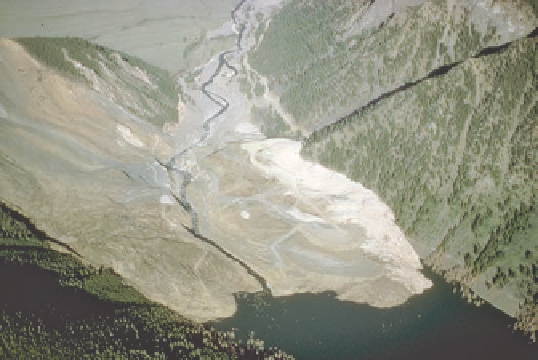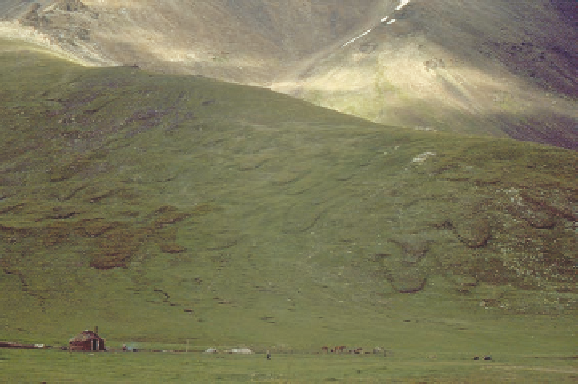Geoscience Reference
In-Depth Information
landslide (Figure 14.20) on a mountain that borders the Madison
River, which flows through the area. Approximately 28 million m
3
(37 million yd
3
) of rock was instantly detached from the mountain
in an area that measured about 600 m (about 2000 ft) in length and
300 m (about 980 ft) in thickness. During the ensuing landslide,
the rock mass slid down the mountain slope, crossed the Madison
River, and, in the process, killed 28 people who had been camp-
ing in the vicinity. The landslide was so large that it dammed the
Madison River, creating a new lake, now known as Earthquake
Lake, which is nearly 100 m (330 ft) deep.
In contrast to debris slides, which flow parallel to the sur-
face, a
slump
occurs when rock and sediment rotate and move
Figure 14.19 The effects of solifluction.
The distinctive lobes
on this hillslope in Kyrgyzstan have evolved because unfrozen
soil becomes saturated in the summer and sags downhill over
underlying permafrost.
impact of seasonal temperature changes on the landscape. Most
of the year, the soil is frozen from the surface to some depth.
During the short summer months, the upper part of the soil
thaws. Water within this part of the soil (the active layer) cannot
percolate very deeply, however, because the sediment beneath it
is continuously frozen as permafrost. As a result, the overlying
(unfrozen) soil becomes saturated and slowly sags downhill in
a very uneven way, producing distinct lobes that overlap one
another (Figure 14.19).
111° W
Landslides
Another form of mass-wasting process is called a
landslide
. As
the name implies, a landslide is a mass of rock, regolith, and
soil that suddenly moves downhill. This movement is initiated
when an event such as an earthquake or period of heavy rain
causes the downward force of gravity to overcome the sedi-
ment's cohesiveness and internal friction. Slope shear strength
depends on the frictional resistance and overall cohesion of the
underlying sediment. When slope shear strength is reduced for
some reason, a portion of a hillslope can move downhill at a
rapid rate, either as a debris slide or a slump.
A
debris slide
occurs when slope failure occurs along a
plane that is roughly parallel to the surface. A famous exam-
ple of a debris slide is the
Madison slide
, which occurred in
Montana near Yellowstone National Park on August 17, 1959
when a magnitude 7.1 earthquake rocked the region late in the
evening for about 30 sec. This earthquake initiated a massive
Hebgen
Lake
MT
45° N
Madison
River Canyon
WY
Cliff Lake
Yellowstone
National
Park
MT
0
25
50 km
0
25
50 mi
Figure 14.20 The Madison slide.
Slopes can instantly fail when
the threshold for cohesiveness is passed, causing tons of rock and
sediment to move rapidly down the hill. The massive Madison slide,
for example, was prompted by a large earthquake in the region. This
slide blocked the Madison River, forming Earthquake Lake (arrow).
Landslide
An instantaneous movement of soil and bedrock
down a steep slope in response to gravity, triggered by an event
such as an earthquake.
Slump
A mass-wasting process in which rock and sediment
rotate and move down the slope along a concave plane relative
to the surface.
Debris slide
A mass-wasting process in which slope failure
occurs along a plane that is roughly parallel to the surface.










































































































































































